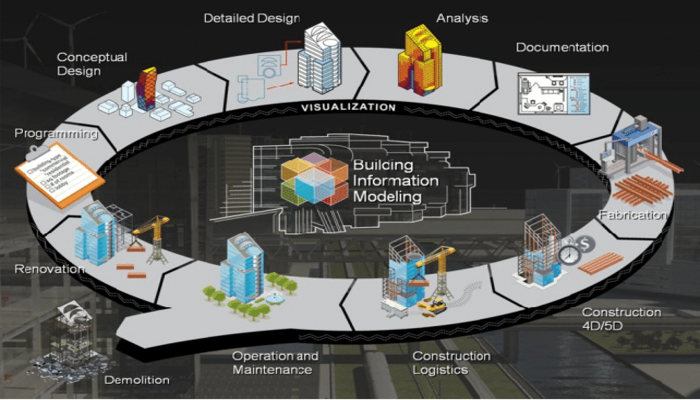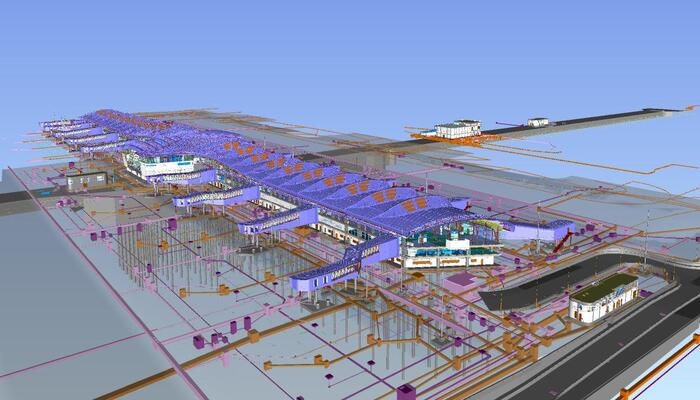How BIM & Digitalisation Are Transforming Construction (2025)

Table of Contents
Evolution is necessary, right? Humans evolved, impacting our lifestyle. Imagine still trying to light fires by striking rocks. But now, we cook food using electricity, travel in cars, and build structures barely imaginable even a few decades earlier. It’s true that technological advancements and digitisation have made our lives easier and helped us work more efficiently. This is exactly what Building Information Modelling (BIM) in the construction industry is doing.
In the dynamic landscape of construction, BIM has become the linchpin of progress. BIM stands as the paragon of innovation for the Architecture, engineering, and Construction (AEC) industry. BIM improves project planning and management, making processes more efficient, productive, collaborative, and functional.
While we are aware of the surface-level facts, let us peel through the layers to understand the impact of BIM and digitisation in the construction industry.
Understanding Digital Transformation in the Construction Industry?
When we think about “Digital Transformation”, we are mostly thinking about a single dimension which involves changing fundamental processes by adopting new technologies. But digital transformation in the construction industry is more than that. In the Architectural, Engineering, and Construction (AEC) industry, digital transformation commenced with a fundamental shift towards becoming data-driven, customer-centric, and collaborative in construction projects.
Integrating digitised processes across interlinked construction phases, right from designing to maintenance, adapting holistic digitisation, and creating the correct mindset leads to better collaboration, productivity, and agile decision-making. Building Information Modelling (BIM) is one such digital tool that helps refine construction processes and results in information-driven decisions.
Impact of Digitisation and Digital Transformation Construction

The importance of digitisation in the AEC industry cannot go unnoticed, as it shows significant improvement in productivity, safety, and quality of building projects. Adopting BIM in construction allows stakeholders to work more efficiently and manage costs while delivering projects on time. Additionally, other technologies like modular construction and prefabrication can reduce waste and contribute to sustainable elements in a design.
With digitisation in the construction industry continuously evolving, stakeholders must adopt these technologies and approaches to stay ahead. Changing the landscape of construction, digital transformation technologies like BIM are taking over the industry!
Now let’s learn about how BIM is digitising the AEC industry.
BIM and Digitisation in the Construction Industry

The construction industry is yet to see a world where digitisation in construction is taking over and directing primary processes during the construction lifecycle. These gaps take shape as challenges that affect the productivity and performance of projects. Almost 69% of homeowners have raised concerns about inefficiency regarding project performance; 80% of construction companies cannot find skilled workers; and 34% of professionals are working with incorrect project data. But do you ever wonder about the reason for this noticeable gap in the AEC industry?
The answer lies in the lack of information-first technology and building analysis tools. While the construction industry is one of the least digitised industries, it is in dire need to be more collaborative, efficient, and precise in its processes. BIM comes forth as a digital transformation for the construction industry not just to optimise pre-construction processes but also for on-site construction. This further minimises waste in the project lifecycle.
BIM in the construction industry allows all stakeholders to have access to real-time project data, empowering complete transparency and control of the project via a Cloud-based Data Environment (CDE). Digitalisation improves data accessibility with system integration while facilitating quality controls and maintenance.
Read : What is BIM for Civil & Structural Engineers, and How Do They Benefit From It
Global BIM Adoption

With BIM in construction becoming a mandatory practice, the global adoption of BIM cannot go unnoticed. While the US is one of the first nations to adopt BIM within organisations, countries like China, Singapore, South Korea, France, the UK, etc. are also pushing for the use of BIM in the public sector. The practice of implementing BIM in the construction industry has risen globally, with multiple non-profit agencies and government organisations looking for BIM standards and solutions.
Benefits of BIM adoption in digitising the construction industry
While Computer-Aided Design (CAD) is widely adopted in the AEC industry, BIM in construction is a step further. Building Information Modelling offers multiple benefits, like detailed visualisation, streamlining communication and collaboration, and assisting in creating cost and time-efficient designs. The ‘I’ in BIM stands for ‘information’ and refers to the insights through informed decision-making. So, what do you think? Is it going to be BIM or just CAD in the service of construction project lifecycles?
1. Efficient Communication and Collaboration with BIM in Construction
Platforms like BIM offer real-time collaboration for information exchange, clash resolution, and improved communication among stakeholders. Involved project contributors can share real-time information and updates that help with identifying and addressing issues, leading to efficient decision-making, reduced errors, and timely project delivery.
2. Improved Safety with BIM in Construction
Okay, okay… BIM helps with faster deliveries, efficient project management, and on-site execution, but what about safety? BIM has that covered too! This allows stakeholders to monitor processes in real-time and check for potential safety hazards with wearable technology like smart helmets and safety vests. Additionally, digital tools can be employed in predicting, identifying, and mitigating safety risks, which ultimately reduces on-site injuries and accidents.
3. Sustainable Construction with BIM in Construction
The revolution transforming the AEC industry is also steering the shift towards sustainability in construction. Digital tools can be employed in platforms like BIM to optimise design and construction processes, manage building materials, and reduce and recycle waste. This ultimately optimises building designs, energy consumption, and material usage in the built form.
4. Increased Efficiency with BIM in Construction
By digitally transforming manual processes, using drones for surveying and inspections, and optimising data collection for models and maps, projects can be made more efficient from start to finish. Additionally, multiple software programs can be employed for data analysis that improves project deliveries.
5. Upgraded Customer Experience with BIM in Construction
Digitisation has revolutionised multiple phases in the project lifecycle, one of which is the customer experience. BIM helps optimise project transparency and accountability by providing digital tools and platforms that ultimately lead to customer satisfaction.
Read : A Comprehensive Guide on Structural Design in Civil Engineering
Barriers to Adopting BIM in the AEC Industry

BIM seems to have it all. So what is coming in the way of its adoption on a larger scale? The AEC industry is still tip-toeing into the realm of complete digitisation, but there are some critical challenges in the way of BIM in the construction industry taking over processes. Let’s dig deeper into the hurdles now:
1. Resistance to Change
Stepping out of your comfort zone and thinking outside the box are easier when used as phrases, but they might sound tedious when implemented in business processes. Digitalisation in the construction industry would require firms to take an extra step and slowly steer toward BIM.
2. BIM vs CAD
AEC professionals feel that BIM might not be worth their time and efforts and are reluctant to completely digitalise construction processes. While they might be working ‘just fine’ with using CAD, it is critical to understand processes that might accelerate productivity and project efficiency.
Read : A Comprehensive Guide on Structural Design in Civil Engineering
Companies That Are Using BIM and Digitalisation in the Construction Industry
There are many companies solely relying on BIM along with many firms adopting this technology with BIM professionals. Let’s discuss some of the best companies in the world that are actively using BIM in their construction projects.
1. VINCI
Founded as SGE in 1899, the Vinci Group (2000) was set up by two engineers from the French engineering school ‘Polytechnique’
While the group is already working on multiple projects across the world, they have not stepped away from implementing BIM throughout the project lifecycle. A good example of BIM implementation is the renovation and extension of the Tottenham Court Road underground station in London.
2. Samsung C&T
Samsung C&T was established in 1938 as the flagship project engineering company within the Samsung Group. Since 1995, the company’s main focus has been on global engineering and construction projects. You must know about the Burj Khalifa in Dubai and the Petronas Tower in Malaysia. These skyscrapers were constructed by the group using BIM in construction projects.
3. Bechtel Corporation
Titled as one of the largest construction firms on a global scale, Bechtel has completed over 25,000 projects, sprawling over 160 countries across all continents, since 1898. Bechtel Corporation has implemented BIM technology on a lot of its projects. For example, Bechtel was able to make an efficient and timely project delivery that involved modernising the Gatwick Aiport without making alterations to the ongoing operations using BIM in the construction process.
4. Morphogenesis
Known for its large-scale projects and manifold portfolio, Morphogenesis has stamped its expertise in the Indian Architectural Landscape. While they have reduced their dependence on CAD for complex designs, Revit has made their lives easier! BIM in the construction industry has helped them deliver projects efficiently and productively.
5. Biome Environmental Solutions
Biome is an in-demand firm that focuses on low-impact ecological designs. They not only use BIM in construction projects methodically but also look for BIM experts while hiring for their organisation. Their goal is to deliver the best solutions to their clients and settle for nothing but the best!
6. BIM and New Construction Standards
We know that the AEC industry is dynamic and is not leaving any stone unturned in optimising its methodologies and processes. With this continual advancement, the fundamentals of BIM are regulated by some international standards. This helps to create an interdisciplinary and collaborative approach that aligns with the methodology of common standards and open workflows.
7. BIM Standards
The initial international BIM standard that is used as a regulatory framework is ISO 19650 (Organization of information on construction works—Management of information in the use of BIM).
ISO 19650 is an international standard that regulates information management during the entire building lifecycle using BIM. Building Information Modelling is a collaborative process for the efficient management of information during project operation and delivery.
What exactly is ISO 19650?
- It has been derived from the British PAS (pas 1192-2: 2013 and PAS 1192-3: 2014).
- It has been designed to be implemented throughout the project lifecycle, right from the design phase to the operation and maintenance phases.
- Has 5 categories:
Part 1: General Principles and Concepts
Part 2: Real Estate Assets and Delivery Stage
Part 3: Information management during the construction phase and other development processes
Part 4: Exchanging Information
Part 5: Information Security Requirements
ISO 19650 is the most important standard of BIM for the construction industry, containing all high-level requirements and the same principles as the UK BIM Framework and being closely related to the current UK 1192 standards. Some other BIM standards are:
- ISO 16739: This standard is used to define the format characteristics of the IFC for data sharing in a BIM process.
- ISO 12006: This standard defines the classification of the components of a built form.
Read : Top 7 Interview Questions and Sample Answers For Civil Engineers
Conclusion
The transformative impact of implementing BIM and digitisation in construction processes in the AEC industry cannot be curtailed. These technological advancements have ushered the construction industry into the realm of achieving sustainability, precision, efficiency, and productivity. BIM helps with creating a comprehensive digital platform with accessible tools and data analytics that further streamlines processes, reduces errors, and improves communication and collaboration amongst stakeholders.
With the dynamic nature of the construction industry's embrace of technological advancements, BIM and digitising construction processes have become crucial to keeping up with demands, industry competition, and changing methodologies and employment practices. The ones who harness these technologies can significantly reap the benefits in the forthcoming years.
If digitisation and BIM in construction processes hit a chord with you, why don't you learn more about them as well? Here’s something that might interest you. Novatr offers a BIM Professional Course for Civil Engineers that will help you understand industry workflows and advanced tools for streamlined construction processes. Learn high-performance computational BIM and building analysis via a live industry project. Bag opportunities along with professional certification, endless career possibilities, and upskilling.

 Thanks for connecting!
Thanks for connecting!

.png)


.jpg)


